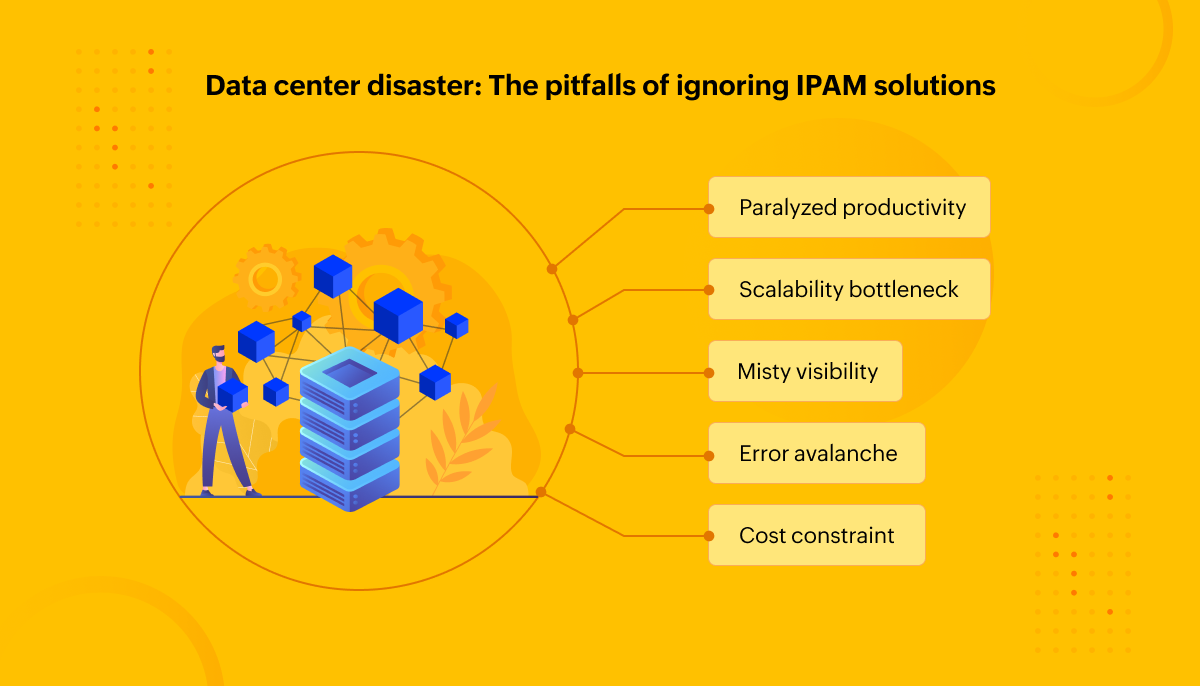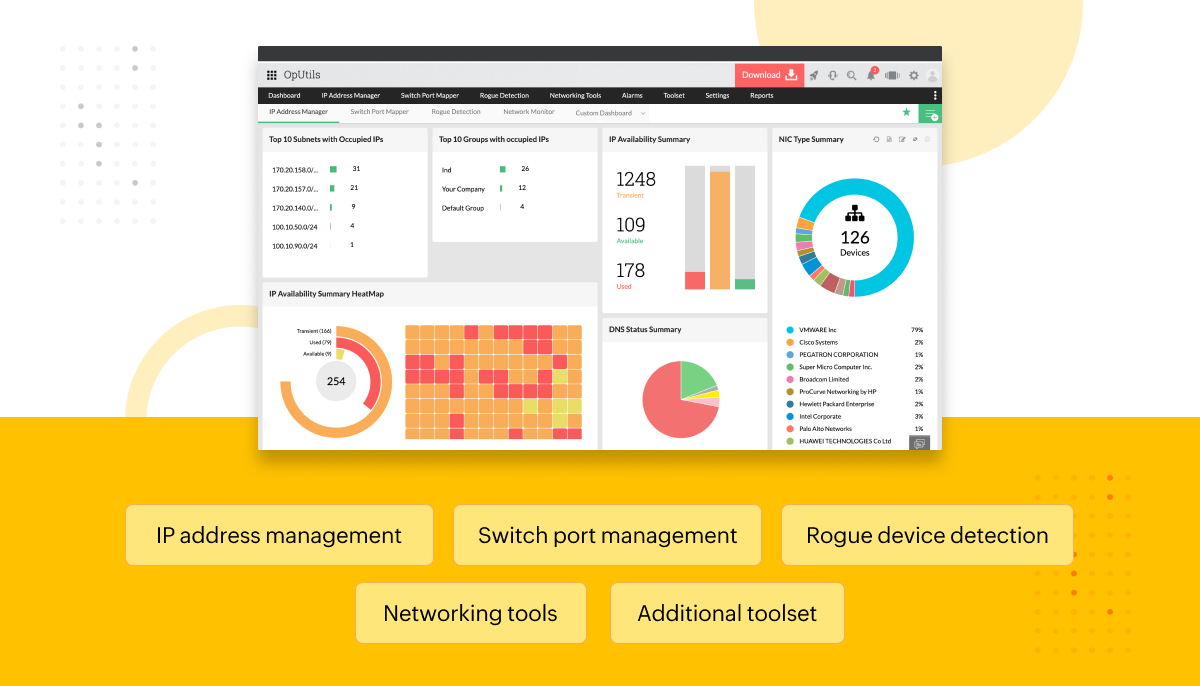Data centers have been transformed with the evolution of new challenges and technologies from strictly on-premises environments to remote locations. Though this provides a lot of advantages, this development comes with its own challenges. Managing this cluster of devices requires precision planning, and modern hybrid architectures don’t end with mere devices. They pulsate with layers of network components like dynamic applications, interconnected services, ubiquitous IP addresses, security-optimization aspects, and ever-evolving virtual devices.
This network ecosystem expands beyond physical boundaries, constantly adapting itself to meet the growing network demands. However, the secret to a seamlessly functioning network is to manage IP addresses efficiently, apart from juggling between complex tapestries of devices, apps, and services.
Let’s understand why data centers—traditional or modern—should invest in an IP address management (IPAM) solution.
Data center disaster: The pitfalls of ignoring IPAM solutions
Imagine the data center without an IPAM solution. Can you visualize multiple IT admins maintaining a galaxy of IPs from a single spreadsheet? Sounds crazy, right? This explains why data centers should use a robust IPAM solution.

Here are some crazy things that happen when IPAM software is not utilized.
Paralyzed productivity:
Without a versatile IPAM solution, the amount of time and resources it takes to manage IPs significantly increases, leading to operational inefficiencies and potential network issues.
An efficient IPAM tool helps IT admins track their IP resources by maintaining information about allocated and unallocated IPs in a centralized location. Having an up-to-date inventory is essential for better network management.
Scalability bottleneck:
Addressing rapid expansion and infrastructure-level changes cannot be accommodated without the appropriate tool. An IPAM solution enables scalability which is necessary to expand operations for cloud deployments or in virtual environments.
With data centers housing a maze of IPs, it is important to strategize IP address planning based on your network’s requirements to navigate through the complexity. A robust IPAM tool helps IT admins manage subnets, optimize IP addresses, prevent IP conflicts, and manage IP allocations.
Misty visibility:
Achieving comprehensive visibility into the IP address space without an IPAM tool is difficult. A lack of visibility results in network blind spots and makes troubleshooting difficult, thereby affecting network management.
IPAM tools help IT admins gain real-time visibility into the IP address territory. Historical data analysis will enable an in-depth drill down into the IP-related issue, while network alerts will throw light into potential conflict areas, aiding the IT admins in taking corrective actions. Proper monitoring ensures a stable network with optimized resources.
Error avalanche:
Without real-time visibility into the network, fault management is challenging as identifying issues before they impact end-users becomes impossible. This situation often results in increased downtime and impedes overall network performance.
With a switch port mapper integrated with the IPAM tool, IT admins can pinpoint issues effectively by tracing them back to the devices connected to the ports. From the security aspect, the switch port mapper helps identify unauthorized device access into the network. If an IP address management tool includes features to detect rogue devices effectively, it adds an extra layer of security and functionality. It prevents rogue devices from consuming excess bandwidth and impacting the network’s performance.
Cost constraint:
With un-optimized IP utilization and increased downtime, spending could be considerably high. IP conflicts occur when two or more devices compete for the same IP. IP conflicts can result in disrupted network connectivity, causing a loss of communication between the conflicting devices.
Utilizing a tool that helps manage IP conflicts ensures a seamless and efficient network operation. Proactive IP management with an IPAM tool reduces errors and increase the ROI of the data center.
Beyond IP headaches: Essential considerations for choosing an IPAM solution
Here are five key aspects to evaluate before selecting an IPAM tool.
- Data center size and complexity: Different levels of complexity for automation and visibility are involved in managing a sprawling data center infrastructure compared to a few servers or network racks.
- Scalability: Choose an IPAM solution that can adapt well to your projected growth, both in terms of network size and functionality.
- Budget and resources: Strike an optimal balance between cost-effectiveness and advanced features to ensure sustained value without putting undue strain on your IT budget.
- Security and compliance: Prioritize solutions that provide strong access control, comprehensive audit trails, and adhere to regulatory requirements.
- Network infrastructure and integration: Choose IPAM software that integrates seamlessly with your existing network infrastructure. Remember, continuously switching between various tools and correlating different sets of data can be inefficient and challenging.
Future-proof your network: Why OpUtils is the data center IPAM solution of tomorrow
ManageEngine OpUtils is designed for IP address and switch port management. This solution enables IT administrators to manage their IP address space efficiently and switch ports. But what if your current IPAM solution also addresses this? This is where OpUtils provides additional operational benefits.

IP address management:
Efficiently manage IPv4 and IPv6 subnets in your network by enabling the advanced IP scanning option, ensuring an up-to-date inventory of all IPs. Gain real-time visibility into your IP address space by analyzing IP and subnet utilization, providing a better understanding of IP availability. The IP History and the Alerts tab is a robust resource that helps IT admins troubleshoot the network effectively. The IP request tool, which is tightly integrated with the IP Address Manager module, helps the IT admin achieve a conflict-free network.
Switch port management:
Utilize the switch port mapper module and port scanner tool to scan, map, and visualize comprehensive insights into your network switch ports. Addressing data center complexity, this module helps the IT admin identify the connected switch port of a device, thereby eliminating manual tracing of network cables and saving a lot of time and effort.
Rogue device detection:
OpUtils performs network scans to provide a comprehensive security overview starting with identifying newly added devices, and categorizing the discovered devices as trusted, guest, or rogue. It then displays detailed information about the switch and port to which each device is connected. OpUtils alerts upon detecting a new device, as well as when the guest validity period expires, ensuring that the IT admin is informed of network changes. Additionally, this powerful tool supports blocking switch ports to prevent unauthorized access, which enhances overall network security and control.
Networking tools:
The networking tools are a set of four resources that help the IT admins monitor the network devices and manage configurations by automating backups for Cisco configuration files. The tools also enable comparisons of various versions of the startup and running configuration files, and track bandwidth usage to facilitate both manual and scheduled boot-up options for inactive machines within a network. Empowering IT admins to delve into the finer details of the network, these tools extend beyond the confines of the IP space and are vital for addressing network issues.
Additional toolset:
OpUtils consists of a toolset featuring more than 30 utilities that simplify administrative responsibilities by eliminating the requirement for multiple tools and data correlations. This enables IT admins to verify system availability, route, and health, scan IP ranges, and check node status. You can utilize tools for TCP port scanning, SNMP-enabled device checks, IP address retrieval, and comprehensive monitoring of critical servers in the network.
OpUtils provides the features you have shortlisted for an IPAM tool. Yes! This solution provides all of them.
Book a live demo with our product experts to explore how OpUtils can enhance your data center’s IPAM journey. Alternatively, seize the opportunity to experience OpUtils hands-on today by downloading a free 30-day trial.

